Published 21/05/2016
A short history of the American flag.
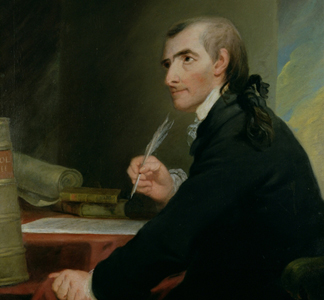
|
As a British colony, our first flag was called the Grand Union (also known as the Continental flag). It combined the British King's colours and the thirteen stripes to signify Colonial unity. On June 14, 1777, the Continental Congress passed the first Flag Act which prescribed, "the flag of the United States be made of thirteen stripes, alternate red and white; that the union be thirteen stars, white in a blue field, representing a new Constellation." Popular lore contends that Betsy Ross, a seamstress from Philadelphia, sewed the first flag at George Washington's request. The story of Mrs. Ross was not made public until 1870 and was immediately challenged. Most historians believe that Francis Hopkinson (left), a Congressman from New Jersey and signer of the Declaration of Independence, designed the first flag a year prior to the Flag Act. In exchange for his design, he requested from Congress a 'Quarter Cask of the public wine' as payment. Hopkinson's design had thirteen six-pointed stars arranged in a staggered pattern. |
|
Another long-standing legend has to do with the design of the circular star pattern. An artist named Charles Weisgerber designed the flag in this manner for his painting, "Birth of Our Nation's Flag" This painting was eventually taken as fact and added to American history texts. The circular star pattern, as depicted in this handsewn flag from the 1830s that is housed in the New-York Historical Society, was also the design thought to be on the Betsy Ross flag. The colors did not originally have meaning on the flag itself, although the colors did have meaning within the Great Seal of the U.S. (right). Charles Thomson, Secretary of the Continental Congress, stated: "The colors of the pales (the vertical stripes) are those used in the flag of the United States of America; White signifies purity and innocence, Red, hardiness & valor, and Blue, the color of the Chief signifies vigilance, perseverance & justice." |
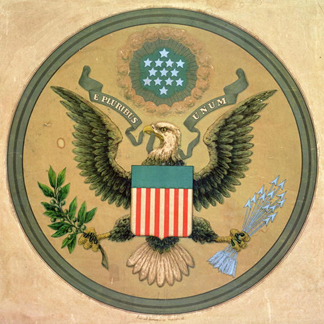
|
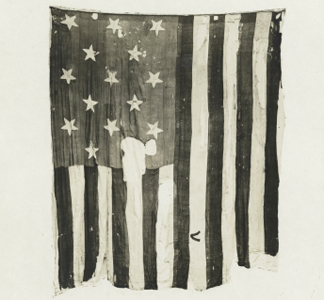
|
During the War of 1812, the commander of Fort McHenryin Baltimore asked for a flag so big that "the British would have no trouble seeing it from a distance." Mary Young Pickersgill and her thirteen year old daughter, Caroline, sewed a flag that measured 30 x 42 feet. Early on the morning of September 13, 1814, the British bombardment of the fort began and lasted for the next 25 hours. When silence fell over the fort and the daylight came, the flag was still there. Francis Scott Key, a Baltimore lawyer who was negotiating for a prisoner exchange, and who observed the battle, wrote a poem that morning entitled "Defense of Fort M'Henry." Soon after the battle, a tune was added to Key's poem and was sung for the first time as "The Star-Spangled Banner." In the Flag Act of 1818, the design was allowed 13 stripes and one star for each state, to be added to the flag on the 4th of July following admission of each new state. One hundred years after the War of 1812, President Taft signed an executive order that established the proportions of the flag and the proper arrangement of the stars. |
During the Civil War years, the Union flag remained constant in its 13 red and white stripes and white stars on a blue background. The arrangement of the stars varied widely, although none were ever removed after states seceded. The Union flag (bottom left) was most likely carried as a calvary flag; the E inside the stars designated the regiment. The Confederate flag design (bottom right) was adopted but never officially enacted as on the battlefield it looked too similar to the "old" flag. The original flag had seven stars, one for each of the Confederate states. The second design, the Confederate Battle Cross is the most recognizable. The Battle Cross was used by the Confederate Army of the Potomac under General Beauregard at the First Battle of Bull Run (or First Manassas) in 1861 and it saw more battle service than any other design and was still in use at the end of the war. There are many examples of regimental flags for both the Union and Confederate troops.
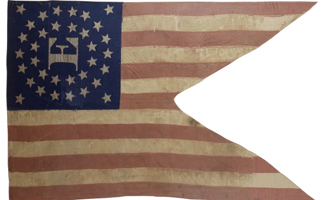
|
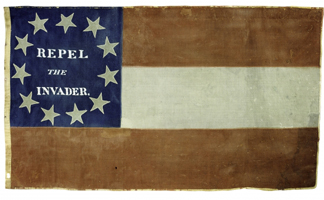
|
|
The current (and 27th) flag was commissioned by executive order of President Eisenhower on August 21, 1959 after Hawaii was admitted to the Union as the 50th state. It was officially flown for the first time on July 4th, 1960. Ten presidents have served under this flag: Dwight D. Eisenhower, John F. Kennedy, Lyndon B. Johnson, Richard M. Nixon, Gerald R. Ford, Jimmy Carter, Ronald Reagan, George Bush, Bill Clinton, George W. Bush and Barack Obama. |

|


